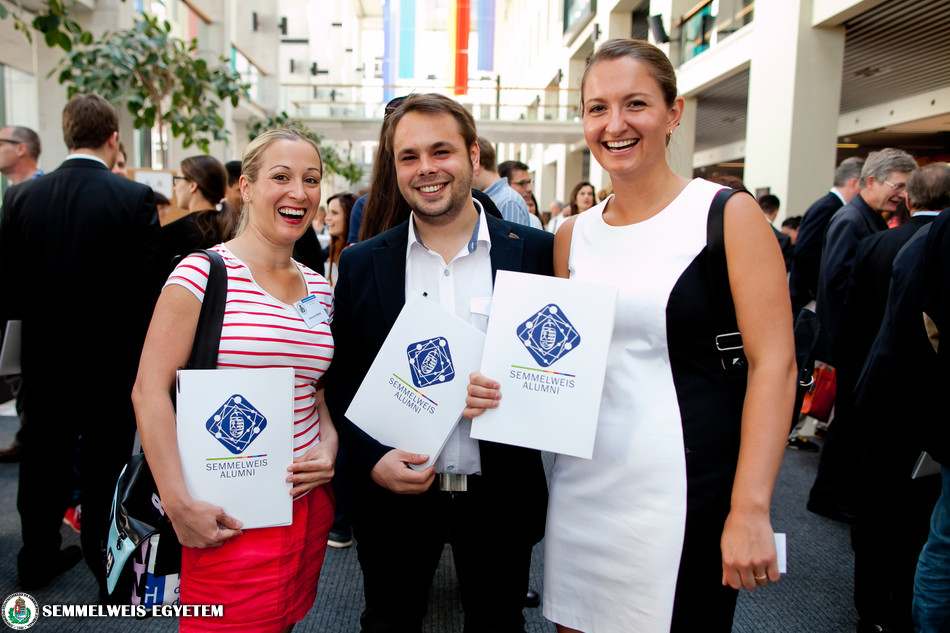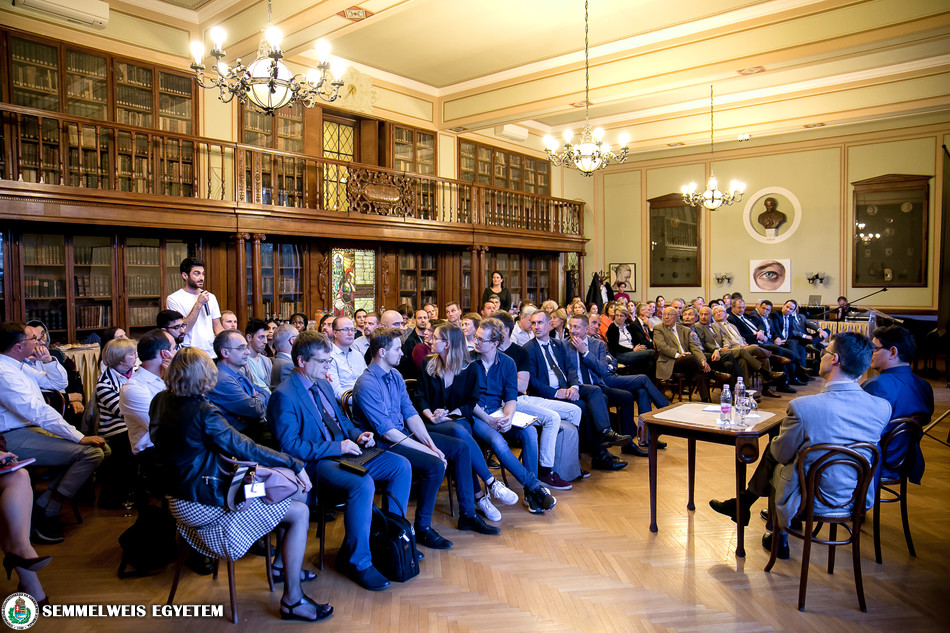The Beginnings: The foundation of the University
In 1769, Maria Theresa added a medical faculty to the University of Nagyszombat, laying the foundations for Semmelweis University. Thus, the history of the institution goes back more than a quarter of a millennium, making it the oldest medical school in Hungary still in operation today. Read more about the history of Semmelweis University here.
Semmelweis University’s medical education has international foundations: the training method was developed by the founding monarch, Queen Maria Theresa’s court physician, Gerard van Swieten of Dutch origin, based on the Viennese medical faculty’s operation, which was reformed on the Leiden model.
The language of instruction was Latin, in accordance with the European practice of the time, for all future doctors of medicine and surgery; for master surgeons and midwifery students, it was Hungarian, German and Slovak. The full transition to Hungarian as the language of education took place after the reconciliation of 1867.
International Training is Launched
German-language education was temporarily offered at the university between 1959 and 1969 already, due to a particular historical situation: the university system of the former GDR could not immediately replace the German doctors who had fled to the West, so tried to involve other socialist countries in the training. Thus, in 1959, 122 German medical students arrived in Budapest accompanied by a lecturer. In the course of ten years, a total of 312 East German students attended the university.
The current international training started 40 years ago, in 1983.
In the early 1980s, Dr. Attila Horváth, President of McDaniel College (previously: College International) and Dr. László Frenyó, Dean of McDaniel College, saw an opportunity to train future doctors in Hungary who were not admitted to medical school in their country due to the limited number of available spots in West Germany. The program attracted 250 applicants, 120 of whom were accepted to start their medical studies in German in September of that year. McDaniel College and Semmelweis University continue to work closely together today. Every year the College organizes a two-semester preparatory course in English and in German with its own lecturers and with those of Semmelweis University. Many of our international medical students have acquired the necessary scientific knowledge for their studies in the preparatory course of McDaniel College.
 German-language training in general medicine started in 1983
German-language training in general medicine started in 1983
The German-language medical education was started by Dr. Attila Fonyó, Director of the Institute of Life Sciences and Dean of the Faculty of Medicine (1985-1991) at the university. The first head of the committee for the operational management of the German-language training courses was Dr. Zoltán Szabó, Professor, and its members were Dr. Tamás Garzó, Assistant Professor, Dr. Pál Blahó, Secretary General, Dr. András Gálszécsi, Deputy Director General for Economics, Dr. Tamás Ács, Senior Research Fellow, and later on, Dr. János Urbancsek, Professor. The current members of the admission committee for German-language trainings are Dr. Pál Röhlich, Dr. Krisztina Káldi, Dr. Ferenc Tölgyesi, Dr. Tamás Kardon and Dr. Gábor Szabó.
In 1987, the range of courses was further expanded, and dental studies were also offered in German.
The first German-language diplomas for medical students were awarded in 1989. Those who have completed their entire training or part of it here “have all integrated into the German medical community without any problems, which is proof of the high quality of medical training in Budapest”, said Frank Ulrich Montgomery, President of the German Medical Association at the 2014 alumni meeting.
In the same year, 1989, English-language medical, dental and pharmaceutical training was launched at the university.
Organizational Changes
Also in 1989, the Foreign Students’ Secretariat was established. By the end of the 1980s, the number of international students applying to Semmelweis University was increasing, which made it necessary to create a new organizational unit. The leaders of this new department were Dr. Anna Kádár (1989-2005), Dr. Márk Kollai (2005-2018), Dr. Erzsébet Ligeti (2005-2014), Dr. Attila Mócsai (2014-2019).
The Operational Committee for English-language trainings dealt with admissions and student affairs until the end of the 2010s. As founding members, Dr. István Gera and Dr. József Mandl played key roles in matters concerning the training of dentists and general practitioners. Dr. Ágnes Kéry was responsible for tasks related to the training of pharmacists. Also members of the committee were Dr. András Csillag, Dr. László Kalabay, Dr. László Tretter and Dr. Andrea Székely.
 The first diploma was awarded to graduates of the English-language program in 1993
The first diploma was awarded to graduates of the English-language program in 1993
The administration of the affairs of international students is carried out by the secretariats. Their role often extends beyond formal administration: they also provide a sense of security and homeliness for young people enrolled in a university in a foreign environment, in a country the language of which is difficult to learn. Magdolna Fonyó has been the head of the student secretariat for German-language training since the beginning in 1983, followed by Edit Gimpl in 2016. Since the start of the English language training in 1989, the student secretariat has been headed by Olga Ványi Orbánné. Since 2022, this task is carried out by Andrea Kevi.
In 2003, hundreds of people attended the alumni meeting organised to celebrate the 20th anniversary of launching the international training.
A year later, in 2004, the range of courses was further expanded with the launch of an English-language course in physiotherapy at the Faculty of Health Sciences.
In 2006, separate student advocacies were set up for students of German and English-language courses. The Deutschsprachige Studentenvertretung Semmelweis (DSVS) and the International Semmelweis Student Association (ISSA) act as a link between the students and the university.
Start of the Campus Hamburg (ACH)
Semmelweis University’s first outsourced training course was launched in 2008. The Asklepios Campus Hamburg (ACH) department offers medical students studying in German the opportunity to continue their studies in Germany, on the Hamburg campus, following a two-year theoretical training in Budapest – on the basis of the Hungarian curriculum. The first diplomas were awarded in 2012. Last academic year, in July 2022, 54 graduates received their degrees at the Hungarian Embassy in Berlin.
 Graduation ceremony in 2016 at the ACH
Graduation ceremony in 2016 at the ACH
The university’s teaching tasks and – as a result of this – its space requirements had increased considerably by 2008. In that year, the new building of Semmelweis University was completed in Tűzoltó Street in Budapest. The Basic Medical Science Center (BMSC or in Hungarian: EOK) meets the demands of the modern age, with laboratories, lecture halls, offices and a state-of-the-art animal house to support successful work and development.
One year after the launch of ACH, Semmelweis University’s off-campus education has been further expanded. Since 2009, the university’s Physiotherapy B.Sc. training is available in English in Lugano, Switzerland. In 2013, the training was also launched in Italian.
Also in that year, the Semmelweis Carnival was organised for the first time, including the International Culinary Festival.
In 2010, Semmelweis University launched its third off-campus training program as part of the Faculty of Public Health. After the start in 2010, one more class of Slovak-language advanced training program in health management was launched in Bratislava in 2012.
Following the German-language medical and dental courses, the university added a German-language pharmacy course in 2011. Students can receive a doctorate in occupational medicine with their degree, which is a curiosity both in Austria and Germany.
 International Alumni Meeting in 2014
International Alumni Meeting in 2014
Continuing the tradition, another anniversary alumni meeting was held in 2014 to celebrate the 30th anniversary of the start of the international training program.
I am proud that what our predecessors dreamed of 30 years ago has become a success story today,”
Dr. Ágoston Szél, then rector of the university said at the opening ceremony.
As part of the international training – but in Hungarian – there are courses in two other countries. In 2017, Semmelweis University started to offer outsourced conductor training in Ilyefalva (Romania), Subotica and Zenta (Serbia), as the András Pető Faculty (PAK) was integrated into the university in the same year. After the training courses of the internationally renowned centre for conductive education, conductors become pedagogical professionals who, with theoretical knowledge and skills, are able to provide conductive education for the development of people with special educational needs (central nervous system disorders) of all ages. The English-language training of conductors started at PAK in 2022.
In 2018, the university developed a new online admission system for foreign applicants: Semaphor (Semmelweis Application Handling and Online Review), helps to receive and process thousands of applications, which are growing every year.
In 2019, the Foreign Students Secretariat (established in 1989) continues to operate under the name of Center of Education of International Studies (CEIS), under the leadership of Dr. Alán Alpár, Vice Rector for International Studies. With the organisational change, the Directorate of International Studies under the leadership of Dr. Miklós Csala was established as part of the unit, with two secretariats, the Division of English Language Programs and the Division of German Language Programs. The university’s international education and student affairs were thus placed under the responsibility of the Vice-Rector. One of the main aims of the reorganisation is to integrate international students into the life of the university.
 The International Student Training Centre was presented at a forum in 2019
The International Student Training Centre was presented at a forum in 2019
Since 2020, the Slovak-language Master’s degree in Health Management is available in Bratislava.
Also in 2020, the university has launched a series of programs to promote student integration, which will offer joint courses for Hungarian and international students. These elective courses are taught in English and offer the opportunity to gain credits, knowledge and contacts for both Hungarian and German or English-speaking students. Two years later, there are more than 70 integrated courses.
Because of the ambitious development of international training, one year before the 40th anniversary, in 2022, Semmelweis University has launched the design of a new building, EOK2.
Jubilee
The Semmelweis International 40 programs, which will start in September this year and run until July 2023, will last the entire academic year. It celebrates the 40th anniversary of international medical training, but it is not just about medical training: it will cover the entire international training offer of Semmelweis University and highlight its achievements. The aim of the project is to commemorate four decades of international training at Semmelweis University and to show and highlight the successes and achievements of the institution.
For more details about the 40-year history of international training see the illustrated timeline, for related events please visit the events calendar.